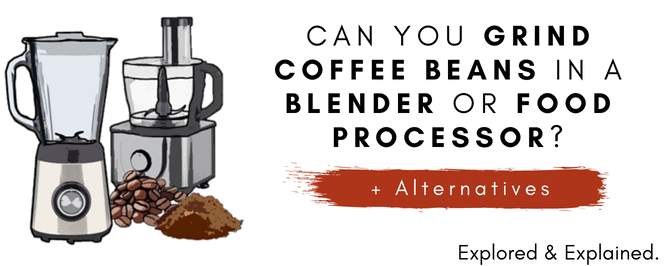Passionate coffee lovers spend their money on expensive gear, but some beginners would argue that there are much cheaper and more accessible alternatives.
A burr grinder is a staple tool in a coffee connoisseur’s life, but can you grind coffee beans in a food processor instead? If so, why do grinders even exist?
Grinding coffee is necessary to provide enough surface area that is exposed to the brew water.
This allows for sufficient extraction of caffeine and flavor compounds, which results in a delicious and energizing cup.
So what makes grinders so special?
After all, in theory, you could use a blender, such as Nutribullet, or a Ninja food processor to crush the coffee into smaller pieces and brew a cup. But can you do that and if so, is it actually a good idea?
If you’ve bought a bag of whole coffee beans by accident, how can you grind them without a grinder? Is there a DIY alternative? Could you make coffee with unground beans?
In this post, I’ll give you all the answers, so let’s dive in!
Can you grind coffee beans in a food processor or blender?
Since we’re discussing whether it’s a good idea to use a blender or a food processor for coffee beans, it’s essential to explain how the grind quality affects extraction.
While brewing a cup, the hot water passes through the coffee grounds and extracts their caffeine, flavor and aromatic compounds, and coffee oils.
Some compounds are easier to extract than others.
When you’re making coffee with an uneven grind, some smaller coffee particles get over-extracted, while others that are larger – under-extracted.
Over-extracted coffee usually tastes harsh and excessively bitter.
Contrarily, under-extracted coffee tastes too acidic and sour.
This means that preparing coffee with an inconsistent coffee grind results in an unbalanced, bad-tasting coffee that’s both unpleasantly bitter and acidic.
Undoubtedly, the best way to grind coffee beans is by using a burr coffee grinder.
This device has two flat or conical burrs.
Between these plates the coffee beans get crushed. Because of their design, burr grinders can grind coffee beans to a uniform size.
This means that you’ll get even extraction, which results in a delicious cup with a balanced flavor.
So let’s go back to the main question:
Can you grind coffee in a food processor?
You can, in fact, grind coffee in a food processor or a blender.
Nevertheless, these kitchen appliances aren’t designed to crush the coffee beans to a uniform size, which would lead to uneven coffee extraction.
Uneven extraction results in an unbalanced cup that’s unpleasantly bitter and acidic.
Furthermore, using a food processor for grinding makes it virtually impossible to control the grind size.
This means that you won’t be able to achieve an adequate size of the coffee particles for the particular brewing method you use.
Moreover, you won’t get to make precise grind adjustments that will improve the flavor of your next brew.
Still, using freshly ground coffee is always better than using a bag of pre-ground beans.
Once crushed into smaller pieces, because of the larger surface area, coffee starts oxidizing and losing its flavor and aromatic compounds at a much faster rate.
This results in a cup that’s much less flavorful and may even taste flat and dull.
Related Post: How Long do Coffee Beans Last?
Therefore, some would argue that using a blade grinder, food processor, or blender is a much better alternative than getting a bag of pre-ground beans.
So if you usually go for pre-ground, and you’ve accidentally bought whole coffee beans, you may be surprised that your cup tastes much better than usual, even if you’ve used a food processor for grinding.
For helpful tips on how to improve your grind when using a blade grinder, you can check out the following video by James Hoffmann:
The recommendations in the video can also be applied when using a food processor or a blender for grinding coffee beans.
Author’s note: Some adventurous coffee lovers have claimed that you can actually make coffee with unground beans.
They report that letting the whole beans simmer for an hour results in a decent cup.
I’ve never tried that, as I feel like I’d be wasting the coffee.
If you don’t have a grinder or a food processor, I recommend using improvised DIY alternatives that will let you crush the beans into smaller pieces.
I wouldn’t go down the whole-bean-brewing route.
Grinding for Espresso in a Food Processor?
It’s also worth mentioning that the type of coffee you’re making needs to be taken into consideration.
It’s virtually impossible to use a food processor for grinding coffee beans for espresso.
True espresso is made by running hot water through a puck of very finely ground coffee under 9 bars of pressure.
Related Post: Espresso vs. Ristretto vs. Lungo: The Comparison
If the coffee particles aren’t uniform, there would be channeling which would affect extraction.
Furthermore, the coffee puck won’t provide enough resistance for the water to reach 9 bars of pressure.
So if you use a food processor instead of a grinder for espresso, you’ll end up disappointed with the final result.
With that being said, if you have a home-grade espresso machine with a pressurized portafilter, using your Magic bullet blender or a Ninja food processor for grinding may work well enough.
For more information, check out my article in which I explain the differences between a pressurized and a non-pressurized portafilter.
These methods are somewhat more forgiving.
However, some would argue that a food processor is good enough for grinding coffee for all brewing methods. These individuals aren’t that rigorous about their coffee’s flavor and about the precision of extraction.
So, as with all things, it all comes down to previous experience, perception, and personal preference.
Improvised Homemade Coffee Grinders
If you want to grind whole coffee beans, but you don’t have a grinder, a food processor, or a blender at hand, you can use a DIY alternative.
Here are some homemade coffee grinder suggestions, that will help you crush the beans when there’s no other alternative:
- Mortar and pestle.
- A wider kitchen knife.
- Put the coffee beans in a ziploc bag and crush them with a kitchen hammer or a rolling pin.
Caution: If you don’t use a ziploc bag, the beans will start flying around while you crush them. So keep that in mind to avoid creating a mess.
Where can I grind coffee beans?
The best place to grind whole coffee beans is in a coffee shop.
There you can ask the barista to set the grinder to an adequate size for the coffee preparation method you use.
Another option would be to use one of the grinders in Whole Foods and Trader Joe’s. There you can pick a setting that matches your brewing device.
With all being said, it’s essential to note that grinding somewhere else or buying pre-ground coffee isn’t ideal.
Your best option, if you want to step up your coffee brewing game, is to invest in a burr coffee grinder.
It will let you grind right before brewing which would have an immense impact on your coffee’s flavor. Furthermore, you’ll be able to easily make adjustments depending on the results you’re getting.
For example, if your coffee turns out too bitter, then you may need to grind it a bit coarser.
If it’s too sour – you could make changes and grind on a finer setting.
Related Posts:
Final Words
In conclusion, you can use a food processor or a blender for grinding coffee, but it isn’t your best option.
Nevertheless, it may be the better alternative to getting pre-ground coffee beans.
After all, grinding right before brewing results in the best-tasting coffee.
Crushing your unground coffee with a mortar and pestle, or a butcher’s knife would also work.
With all being said, if you’re a true coffee lover who’s interested in diving into the world of coffee, I recommend investing in a burr grinder.
Anyway, I hope that you found this post helpful.
Leave me a comment below if you have any questions or simply share your experience! How do you grind your coffee beans if there’s no grinder available?







